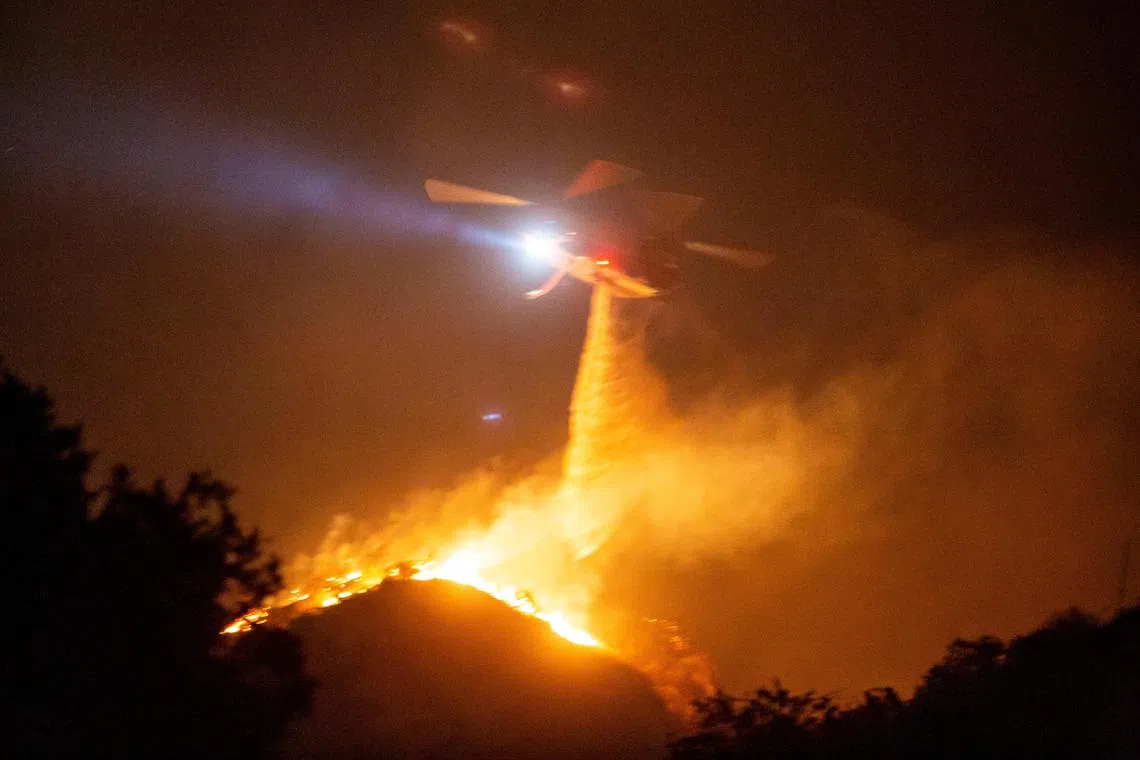Firefighters gain some control over new fire north of LA
Sign up now: Get ST's newsletters delivered to your inbox

Firefighters battling the Hughes fire near Castaic Lake, north of Santa Clarita, California, on Jan 22.
PHOTO: REUTERS
Follow topic:
LOS ANGELES – Fire crews are making progress on blunting the threat from an enormous new blaze north of Los Angeles that forced students to evacuate and prompted inmates to shelter in place.
The Hughes fire has expanded to more than 4,046ha but the blaze is now 14 per cent contained.
The quick mobilisation of resources including aircraft had given firefighters the “upper hand”, Los Angeles County fire chief Anthony Marrone said at a press conference on the afternoon of Jan 22.
“We were able to amass a lot of fire resources early on to change what this fire looks like,” according to Mr Marrone.
“The situation that we’re in today is much different than the situation we were in 16 days ago,” he said, referring to the start of the Palisades and Eaton fires.
The wildfire stoked fresh fears in a region already devastated by two weeks of deadly infernos that have killed 28 people, destroyed nearly 15,000 structures – most of them homes – and left thousands displaced.
The Palisades and Eaton fires, which caused the bulk of the destruction, are still burning but are now more controlled, at 70 per cent and 95 per cent containment, respectively.

Inmate firefighters at work as the Hughes fire burned north of Los Angeles on Jan 22.
PHOTO: AFP
About 50,000 people are under evacuation orders and warnings in the region around the Hughes fire, LA County sheriff Robert Luna said at the press briefing on Jan 22.
He added that 476 inmates at the Pitchess Detention Centre in Castaic were moved to another part of the facility to shelter in place.
There are still concerns about stronger winds, which could fan flames and make firefighting harder.
Winds at higher elevations were forecast to start ramping up on the evening of Jan 22, and will likely increase and peak between 10am and 3pm on Jan 23 across all areas, the National Weather Service said.
Red-flag warnings have been extended to 10am on Jan 24 for most of Los Angeles and Ventura counties, according to the National Weather Service.
The region is facing persistent, dangerous fire weather conditions with low humidity levels and extreme dryness, with Jan 23 the period of greatest concern.
There is a chance of light rain across Southern California starting Jan 24, but firefighters will have to get through the next 1½ days with little help from nature.
Critical fire weather conditions affecting more than nine million people are forecast to last through Jan 23, the US Storm Prediction Centre said.
Winds have the potential to pick up embers and transport them far away, starting new blazes.
Gusts of more than 80kmh were likely overnight on Jan 22 and could climb as high as 112kmh on Jan 23, according to the National Weather Service.
“Obviously this just creates all kinds of havoc with wildland fire behaviour,” said forecaster Rich Bann of the US Weather Prediction Centre. “This creates conditions where you get that explosive fire growth.”

A helicopter dropping water as the Hughes fire burned near Castaic Lake, north of Santa Clarita, California, on Jan 22.
PHOTO: REUTERS
Shares of Californian utilities Edison International and PG&E Corporation fell during late afternoon trading.
Edison closed down 6.3 per cent at US$58.29 at the market close. PG&E dropped 5 per cent to US$16.44.
A spokesperson for Edison said the utility is looking into the situation. It pre-emptively cut power to about 2,300 customers in LA and Ventura counties. PG&E declined to comment on the market activity.
The authorities initially closed a section of Interstate 5, but the route was reopened early in the evening on Jan 22.
About 72km away, a portion of the Pacific Coast Highway – a second major north-south artery into and out of LA – remains shut as the authorities continue work to contain and clean up the Palisades fire.
At the Hughes fire, television images showed a fleet of helicopters repeatedly dumping water on the flames, while bulldozers cut containment lines to prevent the blaze from spreading.
Fire chief Marrone said that the 4,000 firefighters assigned to the blaze will continue working through the night into Jan 23.
“We are going to be on scene all night long, getting more perimeter control, making sure that we can put out the hot spots,” he said. BLOOMBERG

